Sustainability
Sustainability
Environmental Conservation
Conservation of the Global Environment
The OPEN HOUSE Group promotes sustainability aiming to contribute to the realization of a sustainable society through our business activities while achieving sustainable corporate growth. Recognizing that our business activities affect the environment, we will promote initiatives to reduce environmental impact and conserve the environment, both within the Group and throughout our entire value chain.
Our environmental conservation activities are conducted based on our “OPEN HOUSE Group’s Environmental Policy.”
For more information:
OPEN HOUSE Group’s Environmental PolicyOpen House Group’s Approach and Policy on Climate Change
The Group recognizes that climate change is a critical management issue that has a significant impact on business activities and poses a risk to the Group’s goal of “providing housing that customers desire.”
Efforts towards decarbonization are accelerating, including the agreement and enforcement of the Paris Agreement in 2015 and the Japanese government‘s declaration of carbon neutrality by 2050 in 2020.
Under these circumstances, our Group has identified “Contributing to a Decarbonized Society” as one of our materiality issues and has been promoting environmental conservation activities and decarbonization projects. We are also working to reduce greenhouse gas emissions by promoting efficient energy use and the utilization of renewable energy at our business sites and in the housing we provide to customers. Through these efforts, we aim to mitigate the impact of our business activities on climate change.
Going forward, we will expand our specific initiatives through dialogue with our stakeholders.
Agreement with the Recommendations of TCFD
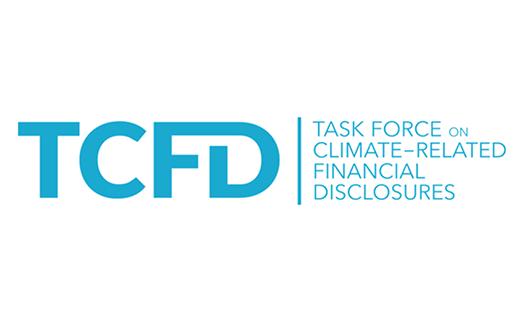
In January 2021, the Group declared its agreement with the recommendations of the Task Force on Climate-related Financial Disclosures (TCFD) to companies for disclosing information regarding risks and opportunities related to climate change. As a member of the TCFD Consortium, a group of Japanese companies that are in agreement with the TCFD, we are working to provide disclosures in line with the TCFD recommendations.
For more information:
TCFD Website (English)Information Disclosure Based on TCFD Recommendations (August 2025)
1. Governance
Our Group has established an organizational governance structure for sustainability issues, including risks and opportunities related to climate change. To promote company-wide policies and initiatives for corporate sustainability, we have established a “Sustainability Committee” under the supervision of the Board of Directors to strengthen the promotion of sustainability.
<Sustainability Promotion System>
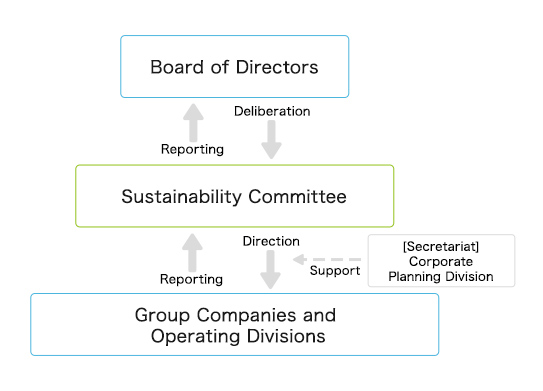
Our Group recognizes climate change as an issue that has a significant impact on management, and has established the Sustainability Committee in November 2019. Positioned as a body to consider sustainability issues, including climate change-related issues, this committee meets once every three months. With the Senior Managing Director CFO as the chairperson and department heads as members, it discusses responses to various sustainability issues.
The committee operates under the supervision of the Board of Directors, managing ESG risks and progress on responses for each materiality item, and collecting information on initiatives from each business division and group company. Progress and results are reported to and discussed by the Sustainability Committee. Important matters discussed are regularly reported to the Board of Directors.
In October 2024, we established a new Sustainability Promotion Department to strengthen sustainability promotion across the entire group. This department serves as the secretariat for the Sustainability Committee, supporting the committee’s operations and promoting sustainability activities both internally and externally.
2. Strategy
Based on the framework proposed by TCFD, our Group has identified the risks and opportunities posed by climate change for all existing businesses. Furthermore, we have evaluated future financial impacts using two scenario analysis methods: a 1.5℃ scenario (focused on transition risks) and a 4℃ scenario (focused on physical risks).
(1) Premise (definitions) for Scenario Analysis
We conducted scenario analysis based on 1.5℃ and 4℃ scenarios to identify significant climate-related risks and opportunities.
| Transition Risks Opportunities | Risks and opportunities associated with changes in policies, regulations, technology, markets, and customer preferences during the transition to a decarbonized society. |
| Physical Risks | Acute risks such as increased frequency and intensity of natural disasters due to climate change, and chronic risks such as rising average temperatures and abnormal weather events. |
| 1.5℃ Scenario | Strict measures against climate change are thoroughly implemented worldwide, successfully curbing global warming. As a result, the average temperature in 2050 will be limited to a 1.5℃ increase compared to pre-industrial levels in the 18th century. |
| 4℃ Scenario | Despite various warnings about global warming, countries fail to align their efforts, ad strict measures are not introduced. As a result, warming progresses further, with average temperatures rising by 4℃, and natural disasters becoming more severe and frequent. |
[Target businesses] All businesses of the Group (Single-family homes, Condominiums, Property Resale, US Real estate)
[Assumed periods] Short-term: Up to 2027, Medium-term: Up to 2030, Long-term: Up to 2050
[Financial impact] Small: Absolute value less than \500 million, Medium: Absolute value \500 million or more but less than \5 billion, Large: Absolute value \5 billion or more
(2) Results of scenario analysis
As a result of the scenario analysis, we have identified the following significant risks and opportunities.
① Transition Risks- We have identified “introduction of carbon pricing” and “strengthening of environmental regulations for housing” as the main risks that will affect our Group.
- Regarding introduction of carbon pricing, we have assessed the medium-term financial impact as “low”. We assume that it will be possible to mitigate the impact by closely monitoring future trends and promoting initiatives that contribute to reducing emissions.
- Regarding strengthening of environmental regulations for single-family homes and condominiums, based on trends such as the government policy on ZEH and mandatory installation of solar panels by some local governments, we have assessed the medium-term financial impact as “medium” in 1.5℃ scenario (assessed as “low” in the 4℃ scenario). As countermeasure, we assume that it will be possible to mitigate the impact by implementing efficient procurement and pursuing economies of scale, utilizing government subsidies, and appealing to customers about the benefits of improved environmental performance in housing.
<Financial Impact of Transition Risks and Future Countermeasure to Promote Impact>
| Transition Risks | Impact | Relevant Business | Financial Impact | Impact Period | Future Countermeasure to Promote | ||||
|---|---|---|---|---|---|---|---|---|---|
| Single-family homes | Condominium | Property esale | US Real estate | 1.5℃ | 4℃ | ||||
| Introduction of Carbon Pricing | Increase in procurement costs for materials, etc. based on introduction of carbon pricing | ● | ● | ● | Low | Low | Medium-term | ・Promoting initiatives with supply chain ・Consideration of alternative materials that contribute to CO2 emission reduction | |
| Increase in fuel costs for company vehicles based on introduction of carbon pricing | ● | ● | ● | Low | Low | Medium-term | ・Introduction of hybrid and electric vehicles | ||
| Increase in electricity usage costs based on introduction of carbon pricing | ● | ● | ● | ● | Low | Low | Medium-term | ・Energy conservation and renewable energy introduction in office | |
| Strengthening of Environmental Regulations for Housing | Increase in costs to comply with strengthened environmental regulations for single-family homes and condominiums | ● | ● | Med. | Low | Medium-term | ・Building a highly efficient supply chain ・Utilization of subsidies ・Value proposition of ZEH etc. to customers ・Consideration of introducing the latest technologies | ||
- We have identified “impacts from intensification of typhoons and floods” and “decreased productivity due to extreme heat” as the main risks affecting our Group.
- We identified five risks regarding the impacts from intensification of typhoons and floods:
- We assessed the medium-term financial impact as “low” for increased costs due to construction work stoppage periods, decreased revenue from discounting houses under construction, and increased costs for preventative measures against damage.
- For the increase in fire insurance costs for real estate held until delivery, we assessed the short-term financial impact as “low”. While we expect this risk to materialize in the medium to long term in Japan, we are considering the possibility of short-term materialization in the US, based on the trend of rising fire insurance premiums due to wildfires in Los Angeles in 2025.
- Regarding the decrease in revenue due to the reduction of constructible areas associated with the expansion of flood-prone areas, we assessed the long-term financial impact as “medium”. Our Group mainly engages in short-term development projects, and we assume it is possible to secure the same scale of revenue early by prioritizing development in areas with low flood risk.
- Regarding decreased productivity due to extreme heat, we identified risks of decreased revenue due to reduced work efficiency of construction workers and reduced sales efficiency of sales staff and have assessed the medium-term financial impact as “low”. We assume that it is possible to mitigate the impact by thoroughly implementing heat stroke prevention measures for construction workers and sales staff.
<Financial Impact of Physical Risks and Future Countermeasure to Promote Impact>
| Physical Risks | Impact | Relevant Business | Financial Impact | Impact Period | Future Countermeasure to Promote | ||||
|---|---|---|---|---|---|---|---|---|---|
| Single-family homes | Condominium | Property esale | US Real estate | 1.5℃ | 4℃ | ||||
| Impacts from Intensification of Typhoons and Floods | Increased costs due to work stoppage caused by typhoons and floods | ● | ● | Low | Low | Medium-term | ・Setting construction periods considering risks ・Preventative measure against damage expansion | ||
| Decreased revenue from houses under construction due to typhoons and floods | ● | Low | Low | Medium-term | Same as above | ||||
| Increased costs for preventive measures against typhoon and flood damage | ● | ● | Low | Low | Medium-term | Same as above | |||
| Increased fire insurance costs for real estate held until delivery | ● | ● | ● | Low | Low | Short-term | ・Consideration of business areas according to the situation | ||
| Decreased revenue due to reduction of constructible areas associated with expansion of flood-prone zones | ● | ● | Med. | Med. | Long-term | ・Shifting markets to areas with low flood risk | |||
| Decreased Productivity Due to Extreme Heat | Decreased revenue due to reduced work efficiency of construction workers caused by extreme heat | ● | ● | ● | Low | Low | Medium-term | ・Introduction of window air conditioners during construction ・Review of work systems and dress codes | |
| Decreased revenue due to reduced work efficiency of sale staff caused by extreme heat | ● | ● | Low | Low | Medium-term | ・Review of work systems and dress codes ・Beverage cost subsidy system | |||
- We have identified “increased demands for environmentally friendly housing” and “increased demand for environmentally friendly services” as the main opportunities for the Group.
- Regarding the expansion of revenue by providing environmentally friendly single-family homes and condominiums, we assessed the financial impact as “medium” in the 1.5℃ scenario, where customer behavior is expected to change along with social trends towards decarbonization (assessed as “low” in the 4℃ scenario). We assume that quickly grasping changes in customer preferences and needs and appropriately revising marketing strategies will be effective in creating opportunities in the future.
- Regarding the increase in demand for environmentally friendly services, we assessed the financial impact of expanding the “Ouchi Link Denki” service, which allows the use of renewable energy-derived electricity, as “low” in both scenarios. We believe that providing the “Ouchi Link Denki” service is an effective means to achieve decarbonization, as it contributes to reducing greenhouse gas emissions for housing usage (Category 11 emissions under Scope 3).
<Financial Impact and Strategies to Capitalize on Opportunities>
| Opportunities | Impact | Relevant Business | Financial Impact | Impact Period | Future Countermeasure to Promote | ||||
|---|---|---|---|---|---|---|---|---|---|
| Single-family homes | Condominium | Property esale | US Real estate | 1.5°C | 4°C | ||||
| Increased Demands for Environmentally Friendly Housing | Increase in revenue from providing environmentally friendly single-family homes and condominiums | ● | ● | Med. | Low | Medium-term | ・Optimization of marketing strategies ・Expansion of product lines ・Review of pricing strategies | ||
| Increased Demand for Environmentally Friendly Services | Increase in revenue from the “Ouchi Link Denki” service that enables the use of renewable energy-derived electricity | ● | ● | Low | Low | Medium-term | ・highlighting convenience and environmental benefits to customers ・Strengthening marketing efforts | ||
3. Risk Management
Under the supervision of the Board of Directors, the Group has established a Sustainability Committee to identify and evaluate risks and opportunities related to sustainability, including climate change-related risks, as well as collect and manage information from each business division and group companies. We have established a system to regularly report the content discussed in the Sustainability Committee to the Board of Directors.
The Sustainability Committee grasps the challenges facing the Group based on global trends in climate change response, such as exchanging information with external experts, discusses necessary measures, and regularly monitors their process. The progress of our Group’s GHG emission reduction targets and initiatives towards reduction are also managed by the Sustainability Committee.
In addition, regarding risks due to the impact of regulations in the housing business, we have established a Construction Subcommittee consisting of group companies directly under the Sustainability Committee. This subcommittee discusses customer trends and responses, and reports to the Management Meeting and Sustainability Committee as appropriate.
In this way, important risks related to group management and the progress of initiatives are regularly reported to the Board of Directors, and we have established a system to appropriately deal with risks and opportunities associated with climate change, which are expected to diversify, expand and intensify in the future.
4. Metrics and targets
(1)Goals
Our Group has set medium- and long-term greenhouse gas (GHG) emission reduction targets to realize a decarbonized society. We aim to reduce GHG emissions (per unit) in Scopes 1, 2, and 3 (*) by 46% in fiscal year 2030 compared to fiscal year 2021 by reducing GHG emissions in our business activities. In fiscal year 2023, we expanded the scope of GHG emissions calculation to a consolidated basis (excluding overseas businesses, etc.), and our Group is working together to contribute to a decarbonized society.
(2)GHG Emissions
The GHG emission reduction targets and actual GHG emissions are as shown below. While expanding our business areas and diversifying our business, we will work to reduce GHG emissions, aiming for sustainable corporate growth and contribution to a decarbonized society simultaneously.
(3)Initiatives to Achieve Goals
Our Group has identified "Contributing to a Decarbonized Society" as one of our materialities, and we are promoting various initiatives to realize a sustainable society while collaborating with stakeholders as a unified group. While considering customer needs, we will promote the installation of solar power generation systems for homes, ZEH and ZEH condominiums, and offer residential electricity using effectively renewable energy. Through these measures, we will actively implement strategies to reduce GHG emissions in our main housing-related business.
In addition, we will continue to collect and aggregate data on GHG emissions in our business activities and monitor emission reduction efforts to reduce GHG emissions. In the future, we will consider formulating a long-term decarbonization transition plan towards carbon neutrality by 2050.
Our group aims to reduce greenhouse gas (GHG) emissions (per unit) by 46% by fiscal year 2030 compared to fiscal year 2021 and achieve net zero by fiscal year 2050.
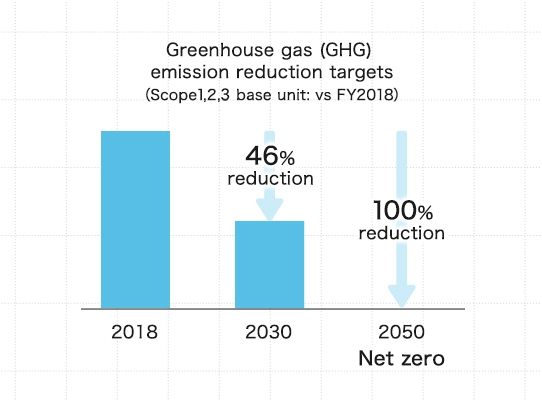
*Reporting boundary: Consolidated basis (excluding overseas operations and certain businesses)
- Scope 1
- : emissions from the business activities of covered companies (direct emissions)
- Scope 2
- : emissions produced from the use of energy provided by other companies (indirect emissions)
- Scope 3
- : emissions from other business activities (indirect emissions mainly from materials procurement and the use of homes after sale)
Initiatives to Reduce Greenhouse Gas Emissions and Promote Energy-Saving in Products
The Group considers that climate change due to greenhouse gas emissions will have a significant impact on the long-term sustainability of society. In addition, we recognize that abnormal weather and natural disasters caused by climate change could pose serious risks to our business activities and growth. We are therefore promoting initiatives on various fronts, such as reducing greenhouse gas emissions associated with business activities and promoting energy-saving in houses.
Our initiatives to reduce greenhouse gas emissions in each business year are as follows.
GHG Emissions
Unit: t-CO₂
| Scope/Category | FY2021 | FY2022 | FY2023 | FY2024 | |
|---|---|---|---|---|---|
| Scope 1 | 3,104 | 3,462 | 3,335 | 3,842 | |
| Scope 2 | 20,188 | 19,994 | 15,076 | 15,229 | |
| Scope 3 | 3,147,962 | 3,258,334 | 2,775,007 | 2,838,284 | |
| Category 1. Purchased goods and services | 1,218,215 | 1,371,269 | 701,116 | 638,797 | |
| Category 2. Capital goods | 17,001 | 7,786 | 5,260 | 1,442 | |
| Category 3. Fuel and energy-related activities | 2,686 | 2,657 | 3,059 | 3,171 | |
| Category 4. Upstream transportation and distribution | 221 | 209 | Included in Category 1 | Included in Category 1 | |
| Category 5. Waste generated in operations | 11,543 | 14,787 | 35,521 | 44,548 | |
| Category 6. Business travel | 1,048 | 1,036 | 658 | 727 | |
| Category 7. Employee commuting | 1,250 | 1,381 | 1,304 | 1,390 | |
| Category 8. Upstream leased assets | - | - | - | - | |
| Category 9. Downstream transportation and distribution | - | - | - | - | |
| Category 10. Processing of sold products | - | - | - | - | |
| Category 11. Use of sold products | 1,894,609 | 1,857,783 | 2,020,499 | 2,135,396 | |
| Category 12. End-of-life treatment of sold products | 1,389 | 1,426 | 7,590 | 12,812 | |
| Category 13. Downstream leased assets | - | - | - | - | |
| Category 14. Franchises | - | - | - | - | |
| Category 15. Investments | - | - | - | - | |
| Total emissions (Scope 1, 2 & 3) | 3,171,254 | 3,281,790 | 2,793,418 | 2,857,355 | |
*Calculation scope: Open House Group Co., Ltd. and its consolidated subsidiaries (excluding overseas operations, etc.)
*Category 8, 9, 10, 13, 14 and 15 are not applicable
Third-Party Assurance
Our company has obtained third-party assurance for our GHG emissions.
For more information:
Verification Statement (FY2023)
Verification Statement (FY2024)
Scope 1, 2, & 3 Emissions and Intensity
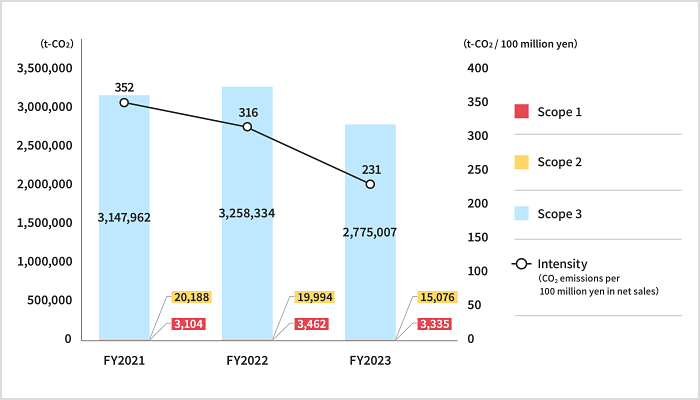
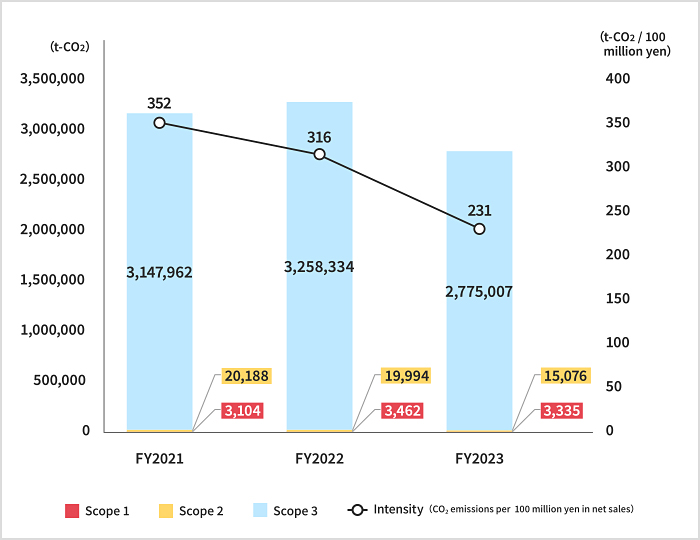
Energy Consumption by Type
Unit: GJ
| Energy type | FY2021 | FY2022 | FY2023 | FY2024 |
|---|---|---|---|---|
| Gasoline | 40,227 | 39,539 | 47,270 | 53,417 |
| City gas | 5,960 | 12,962 | 1,844 | 3,538 |
| LP gas | 2,258 | 6,591 | ー | ー |
| Electricity | 385,038 | 391,718 | 300,520 | 307,631 |
| Thermal | ー | ー | 2,387 | 2,996 |
| Total Energy Consumption | 433,483 | 450,809 | 352,021 | 367,582 |
*Calculation scope: Open House Group Co., Ltd. and its consolidated subsidiaries (excluding overseas operations, etc.)
Initiatives to Reduce Greenhouse Gas Emissions and Promote Energy-Saving in Products
We use insulation materials in all of our buildings. We aim to reduce the environmental impact of customers living in the houses we supply. To do this, we build houses that have high air conditioning efficiency by insulating all walls, etc. that are in contact with outside air using high-performance glass wool that has superior airtightness and moisture repelling properties to ordinary glass wool.
Moreover, at Open House Architect Co., Ltd., non-fluorocarbon insulation materials are used for all insulation to create houses that take LCCO2* into consideration.
Until now, fluorocarbon gas has been used as a foaming agent to create plastic-foam type insulation material. However, the fluorocarbon gas released in the manufacture, use, and disposal of insulation materials destroyed the ozone layer and had a significant impact on global warming, and its use is now restricted. The substitute fluorocarbon that has been used in its place does not harm the ozone layer; however, it has a powerful greenhouse effect. Therefore, the government has been promoting the use of non-fluorocarbon products.
In addition, our group conducts forest conservation activities "Open House Forest Training" in line with our business initiatives.
The purpose of this training is to contribute to the maintenance of multi-functional forests, such as carbon dioxide absorption and biodiversity conservation, as part of the "Regional Co-creation Project" promoted by our group.
The area of the "Open House Forest " is about 2.5ha, and the mean quantity of carbon dioxide absorbed by the forest trees is estimated to be about 149t.
For more information:
Regional Co-creation Project* LCCO2: The CO2 emission reduction effect over the life cycle of a building. It refers to the total amount of CO2 emissions from the construction to demolition and disposal of a building.
Approach to Promoting Green Certification Acquisition for Buildings
ZEH* Promotion Targets and Results
* ZEH: Net zero energy house
Open House Development Co., Ltd.
| Fiscal year | 2020 | 2021 | 2022 | 2023 | 2024 | 2025 | |
|---|---|---|---|---|---|---|---|
| Promotion target | 50% | 50% | 50% | 50% | 50% | ⇒ | 50% |
| Result | 0% | 1% | 2% | 3% | 4% |
Fiscal year: April of the year to March of the following year
Open House Architect Co., Ltd.
| Fiscal year | 2020 | 2021 | 2022 | 2023 | 2024 | 2025 | |
|---|---|---|---|---|---|---|---|
| Promotion target | 65% | 5% | 10% | 20% | 30% | ⇒ | 50% |
| Result | 0% | 0% | 0.02% | 0% | 0% |
Fiscal year: April of the year to March of the following year
The Group companies, Open House Architect Co., Ltd. and Open House Development Co., Ltd., have been registered as "ZEH Builders/Planners" with the Sustainable Open Innovation Initiative (SII). The Group will continue its efforts towards the widespread adoption of ZEH.
Compliance with Housing Performance Indication System
The housing performance indication system is designed to allow comparison and consideration of the functions of newly built houses such as earthquake resistance and energy-saving in advance. The system involves objective evaluations of the house by a third-party institution at the design and construction phases according to common rules. The Group makes proposals that comply with the housing performance indication system at customers’ request.
Initiatives for Biodiversity
ONE TREE MAKE A FOREST PROJECT
The Group understands the importance of preserving the natural environment. As part of our commitment, we strategically incorporate green spaces in our housing developments, even within the constraints of limited land areas. This approach not only enhances the living environment but also contributes to biodiversity conservation.
We are working to conserve biodiversity by promoting the planting of detached houses in central Tokyo using ONE TREE, MAKE A FOREST PROJECT that we are developing in our group's detached house business, which makes the most of our experienced and planning capabilities in constructing detached houses in central Tokyo, thereby promoting the creation of a greener environment.
Approach to Water Use
Because we do not have our own tenants or factories, tap water is the main source of the water that we use. A certain amount of water is required at construction sites, however given the amount of use, there is no serious concern over water risk for the foreseeable future.
However, we recognize the possibility of increasing construction costs due to disaster response caused by climate change. To ensure that everyone can use hygienic water in a sustainable state, we see a need for policies to prevent over-consumption of the water used in the real estate that we provide.
As a company that offers homes for people’s everyday lives, we strive to streamline and improve water use by not only encouraging employees and construction sites to conserve water, but also by engaging our supply chain.
Water Conservation Initiatives
We create internal awareness about water conservation through regular internal notifications. With the recognition that water is a limited resource, each of our employees takes care to conserve water not only at our business locations, but also in their everyday lives. We are working to instill an awareness of reducing the amount of water usage throughout the entire Group.
Water Usage
At single-family home construction sites, the majority of water usage is for foundation and ground improvement work. We expect an increase in our water usage proportionate to the increase in houses constructed as we grow. Looking ahead, we will continue to manage the amount of water usage on construction sites, being mindful to save water.
Water Consumption (Water withdrawal: water supply)
| FY2020 | FY2021 | FY2022 | FY2023 | FY2024 | |
|---|---|---|---|---|---|
| Water usage (㎥) | 167,151 | 170,899 | 299,177 | 245,918 | 214,214 |
| Number of houses delivered | 4,930 | 5,109 | 6,532 | 5,029 | 4,803 |
| Water usage per house (㎥) | 33.9 | 33.4 | 45.8 | 48.9 | 44.6 |
Water withdrawal is only from the water supply.
Water discharge (Drainage destination: sewage)
| FY2020 | FY2021 | FY2022 | FY2023 | FY2024 | |
|---|---|---|---|---|---|
| Water discharge (㎥) | 167,151 | 170,899 | 299,177 | 245,918 | 214,214 |
| Number of houses delivered | 4,930 | 5,109 | 6,532 | 5,029 | 4,803 |
| Water discharge per house (㎥) | 33.9 | 33.4 | 45.8 | 48.9 | 44.6 |
There is no discharge destination other than the sewer system.
[Note on calculation data]
Subject of the calculation: Clean water usage at construction sites of single-family homes
Water Risk Assessments
The OPEN HOUSE Group uses the Aqueduct assessment tool developed by the World Resources Institute (WRI) to recognize water stress and risk at its business sites. We confirm the assessment of water stress and water risk at our main business sites in Japan and overseas.
Aqueduct is a tool that maps the water risks such as flooding, drought, and water stress, then provides users around the world with water-related information to encourage best practices in water resource management.
To promote appropriate water use going forward, we will conduct periodic risk assessments of each major business area to assess the situation and make employees aware of saving water, aiming to ascertain and reduce water risks.
For more information:
Aqueduct Webpage of World Resources Institute WebsiteWater Risk Assessment (2025)
| Water risk level* | Number of sites |
|---|---|
| Low (0–1) | 0 |
| Low-Medium (1–2) | 11 |
| Medium-High (2–3) | 0 |
| High (3–4) | 2 |
| Extremely High (4–5) | 0 |
* Aqueduct assessment standard
For more information:
List of sites subject to Aqueduct evaluationRaw material used (tonnes)
(During construction of single-family homes by Open House Development Co., Ltd.)
Unit: t
| FY2020 | FY2021 | FY2022 | FY2023 | FY2024 | |
|---|---|---|---|---|---|
| Lumber | 56,249 | 39,711 | 51,115 | 35,050 | 26,085 |
| Ready mix concrete | 203,380 | 144,847 | 196,139 | 189,371 | 214,144 |
| Rebar | 6,393 | 4,706 | 5,923 | 5,627 | 6,596 |
| Total | 266,022 | 189,264 | 253,178 | 230,048 | 246,825 |
Approach to Waste Reduction and Resource Recycling
The OPEN HOUSE Group recognizes that using limited resources without waste and reducing waste by recycling and so forth is an important priority for conserving the environment.
To help create a recycling-oriented society, we comply with laws, regulations, and ordinances regarding air, water, and soil pollution, as well as other harmful substances, and strive to prevent environmental pollution by curbing emissions of pollutants. We also manage and process industrial waste generated during construction appropriately, and work to prevent impacts from harmful substances on the environment and building users’ health. Moreover, the Group selects waste collection providers that put an emphasis on reuse of resources. For waste that cannot be reused or recycled, we will process it correctly and work to prevent impacts of the waste on the environment.
Initiatives to Reduce Waste in Our Businesses
The majority of the waste in our businesses is associated with construction materials.
To reduce waste, we order interior wall materials pre-cut to size and have them shipped to the building site. We do the same with exterior wall materials as well.
Open House Architect Co., Ltd. uses factory pre-cut materials in a proprietary panel construction method that increases the efficiency of material processing and reduces material loss.
Furthermore, the entire OPEN HOUSE Group actively uses construction materials that are easy to reuse. In doing so, we strive to create houses that help to reduce both CO2 emissions and the impact of houses on the global environment.
We are installing eco-stations at home games of the OPEN HOUSE Group’s Gunma Crane Thunders, a Japanese professional basketball team. The eco-stations are operated through cooperation with partner companies engaged in environmental businesses in the Gunma Crane Thunders’ hometown of Ota City, Gunma Prefecture. In addition to separating and weighing trash, the eco-stations create awareness about beautifying the local community and reducing waste.
Waste Generation
Unit: t
| FY2021 | FY2022 | FY2023 | FY2024 | |
|---|---|---|---|---|
| Total | 125,325 | 167,611 | 211,425 | 146,631 |
| Recycled | 86,056 | 110,303 | 133,283 | 96,379 |
| Non-Recycled | 39,269 | 57,309 | 78,142 | 50,252 |
| Recycling Rate | 69% | 66% | 63% | 66% |
Aggregation scope: Open House Group (FY2021-2022), Open House & Meldia Group (FY2023 onwards)
Waste Generation (FY2024)
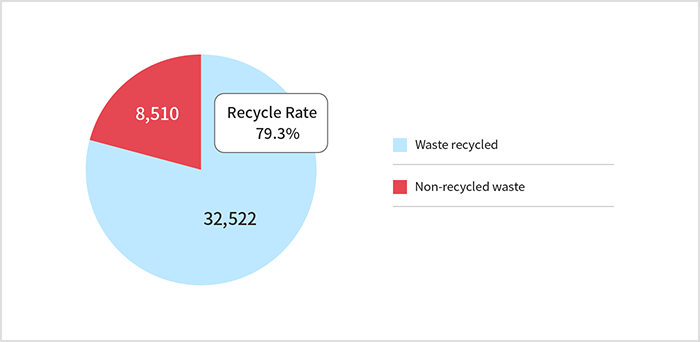
Third-Party Assurance
Our company has obtained third-party assurance for our waste generation volume.
For more information:
Verification Statement (FY2023)
Verification Statement (FY2024)
Approach to Harmful Substance Controls and Pollution Prevention
With the growth of our business and the accompanying increase in the creation of harmful substances, we recognize that the reduced creation of waste and appropriate disposal are important management issues.
We also believe that reducing pollutant emissions is one responsibility of companies.
In cooperation with our supply chain, we are working to prevent emissions of harmful substances, to reduce pollutants by not using the materials that cause them, and to realize a recycling society through the appropriate use of resources.
Initiatives to Harmful Substance Controls and Pollution Prevention
The Group appropriately processes and controls harmful substances in accordance with various laws and regulations. As of fiscal 2024, there have been no violations of environmental laws and regulations or environmental accidents since fiscal 2017.
Pollutants and other emissions
Unit: t
| FY2020 | FY2021 | FY2022 | FY2023 | FY2024 | |
|---|---|---|---|---|---|
| NOX | 11 | 11 | 12 | 14 | 25 |
| SOX | 0 | 0 | 0 | 0 | 0 |
| VOC | 0 | 0 | 0 | 0 | 0 |
| PCB | 0 | 0 | 0 | 0 | 0 |
Ratio of Business Locations Which Have Received Environmental Management System Certifications
We have no business locations which have received environmental management certifications such as ISO14001 or EMAS.
Sustainability
Materialities
Promoting Sustainability
Environmental Conservation
Providing and Ensuring Product
Safety and Security, and Promoting
Customer SatisfactionProducts That Contribute to Solving
Social IssuesTalent Development and Labor
PracticesWork-Style Reforms and Promoting
DiversityHealth and Safety
Respecting Human Rights
Supply Chain Management
Regional co-creation Project
Social Contributions
Compliance
ESG Information Index
